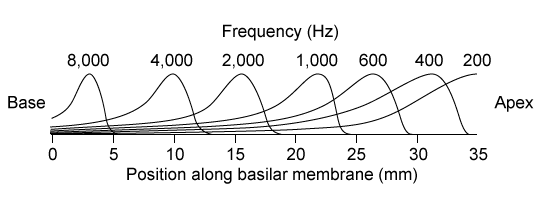Passage
Sound waves propagate through many conducting structures in the ear before they are transduced into neuronal signals. When sound waves reach the fluid-filled cochlea, they are detected by hair cells lining the basilar membrane. The cochlear spiral can be modeled as a resonator system because each section of the basilar membrane is sensitive to a specific frequency (Figure 1) .
 Figure 1 Amplitude pattern of the basilar membrane for different frequenciesPresbycusis (age-related hearing loss) results from a combination of factors that lessens an individual's mechanical and/or neurological sensitivity to sound. Pure tone audiometry (PTA) is used to determine an individual's ability to detect different sound frequencies and can be used to evaluate presbycusis. A "pure" tone is characterized by a single sinusoidal waveform. An audiogram plots the relative intensity required of a given frequency to be detected by the individual (Figure 2) .
Figure 1 Amplitude pattern of the basilar membrane for different frequenciesPresbycusis (age-related hearing loss) results from a combination of factors that lessens an individual's mechanical and/or neurological sensitivity to sound. Pure tone audiometry (PTA) is used to determine an individual's ability to detect different sound frequencies and can be used to evaluate presbycusis. A "pure" tone is characterized by a single sinusoidal waveform. An audiogram plots the relative intensity required of a given frequency to be detected by the individual (Figure 2) .
 Figure 2 Audiogram of an elderly patient exhibiting presbycusis
Figure 2 Audiogram of an elderly patient exhibiting presbycusis
-The earliest stethoscope was simply a wooden pipe open at both ends. The fundamental frequency of a 0.25-m stethoscope will cause resonance at approximately what distance along the basilar membrane from its base? (Note: Use 350 m/s for the speed of sound in air.)
A) 7 mm
B) 16 mm
C) 25 mm
D) 32 mm
Correct Answer:
Verified
Q86: Passage
Laparoscopy is a minimally invasive surgical procedure
Q87: Passage
Cable theory is a mathematical model used
Q88: Passage
Cable theory is a mathematical model used
Q89: Passage
Hydrostatic weighing is a technique used to
Q90: Passage
Hydrostatic weighing is a technique used to
Q92: Passage
Hydrostatic weighing is a technique used to
Q93: Passage
Sound waves propagate through many conducting structures
Q94: Passage
Laparoscopy is a minimally invasive surgical procedure
Q95: Passage
Cable theory is a mathematical model used
Q96: Passage
Cable theory is a mathematical model used
Unlock this Answer For Free Now!
View this answer and more for free by performing one of the following actions

Scan the QR code to install the App and get 2 free unlocks

Unlock quizzes for free by uploading documents